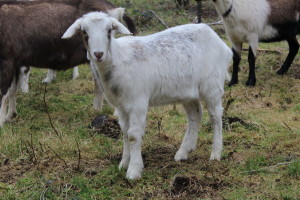You hear that making cheese is an art. It is. But I’ll tell you a secret: some recipes are really easy. Take a big pot. Add milk. Heat. Cool. Add cheese cultures and rennet. Let sit. Strain through cheesecloth. Add herbs, salt, pepper, garlic. Voila — herbed chevre. More people should try making it.
Before the cheese making in the kitchen begins, however, you need milk. And getting fresh organic goat’s milk can be really challenging.
Twenty-two years ago when we first started keeping goats, buying organic feed was far from our minds. We were new farmers caught on the steep slope of the learning curve. We knew how to garden without chemical pesticides and herbicides, but we were entirely new to animal husbandry. We had a book. We tried to follow the rules. Our fences didn’t work. The goats ate the organic bark off our young apple trees, and harvested our organic sweet corn for us, just days before we planned to do it ourselves. We lost animals to disease and bad luck.
We went to the feed store and got Purina goat chow (until we read the label) and finally settled on a mix of cracked corn, oats, barley soybean meal and sunflower seeds. It wasn’t organic, but we made the assumption that it was basically healthy.
Then one by one many of the ingredients in our feed mix began to be replaced by genetically modified ingredients. Conventionally grown grains no longer seemed benign. So we started to feed less grain and more alfalfa. And then we lost alfalfa to genetic modification too.
As our awareness increased over the years, I spent more time thinking about the farmers that grow the grains and grasses that sustain livestock all over the country. I began to realize that there were some big problems with the way animal feed is farmed. The GMO issue highlighted this issue for me and strengthened my resolve to do the extra work required to feed my animals an organic diet.
Ultimately, I learned that I could go to a feed store in Portland to get organic grain (Concentrates, in Milwaukee), and that we were incredibly fortunate to have an organic dairy down the road that would sell us alfalfa and hay.
Yet each year it becomes more challenging for organic farmers. As more genetically modified crops are approved, the farmers that continue to grow organic are surrounded and affected, not only by the drift from pesticides sprayed on neighboring crops that require ever increasing loads of chemicals, but by airborne pollens that change the very nature of the organic farmer’s crop.
This is one of the reasons I support the labeling of foods containing GMOs. Labeling helps consumers make informed decisions. Yet, labels will be meaningless without the ability to regulate GMO crops on the state and local level to protect the integrity of our organic crops.
It is a joy to eat artfully grown and produced food. We must demand our right to do so.
Goat Cheese Pie
1 pie crust (Your choice, white flour, whole wheat, gluten free). Partially pre-bake for 8 minutes at 425 degrees, and set aside.
2 leeks
2 cloves garlic
1 lb greens (kale, chard, spinach etc)
marjoram, oregano, basil, parsley leaves to taste
butter
Saute onions and garlic, add the greens a handful at a time until greens are soft. Add fresh herbs right at the end. Set aside.
3 eggs
5 oz chevre (or more if you have it)
¾ c milk
¾ c heavy cream
nutmeg
Beat together eggs and ½ the chevre. Add milk and a sprinkling of nutmeg.
Preheat the oven to 375. Lay the veggie mix over the bottom of the pie crust. Crumble the remaining chevre over the veggies. Pour the custard over the top.
Bake for 35-45 min. Test with a paring knife. It will be done when the knife comes out clean. Let rest for 5-10 minutes before serving.
My adaptation of a recipe from the Greens Cookbook.

Leave a Reply